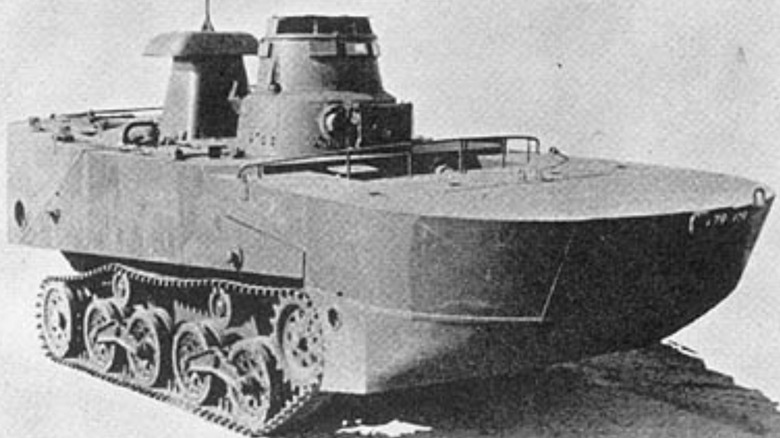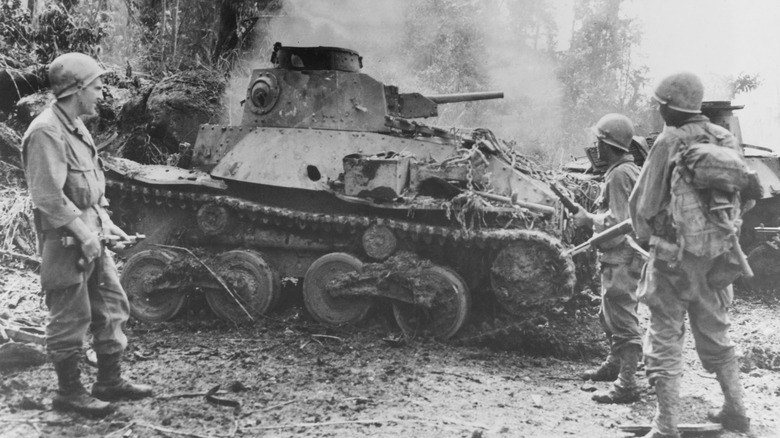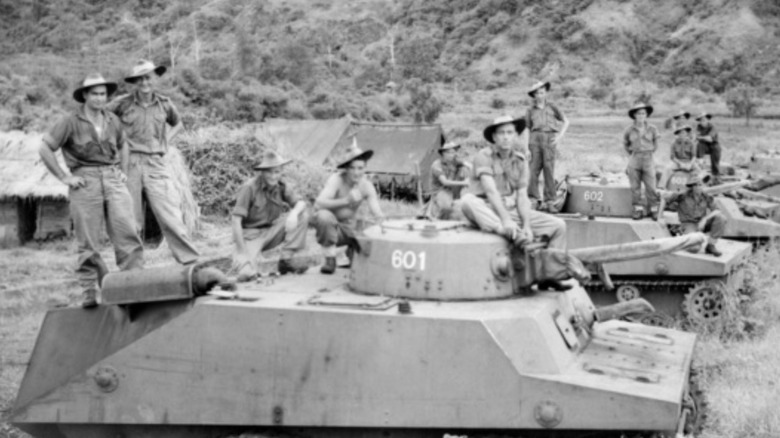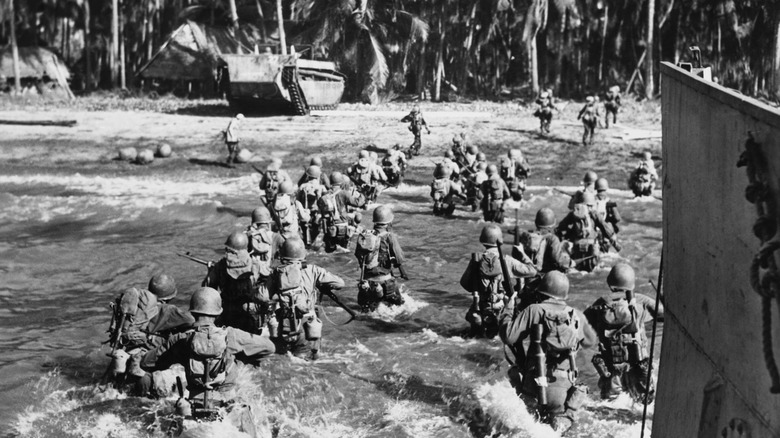Breaking Boundaries: The History Of Japan's Floating Amphibious Tank
For all their firepower, defensive utility, and all-around menacing power on the battlefield, tanks have some debilitating weaknesses. For one thing, the maintenance and supplies required by a large tank division can be a logistical nightmare, and anti-tank weaponry fielded by ground forces can be an incredibly cost-effective way to take them out of commission (even with advanced defenses such as the Trophy system in place).
They also tend to be rather situational in terms of how and where they can be deployed. The great size and weight of the average main battle tank renders it impractical to use in difficult terrain. However, it's now been more than a century since the tank made its combat debut during the Battle of the Somme in September 1916, and these devastating machines have seen countless design innovations in all that time.
One of the most astonishing, as a concept alone, was the development of the amphibious tank. The Japanese were among the pioneers of the non-water-averse tank. How did they do it, and how did the resulting machines perform? Here's a look at the development of the Japanese floating tank, what it could do, and what became of it.
[Featured image by Imperial Japanese Navy via Wikimedia Commons | Cropped and scaled | Public Domain]
Creation of the Type 95 Ha-Go predecessor
In the history of unique, utility-based Japanese tanks, the Type 2 Ka-Mi was preceded by another: the Type 95 Ha-Go light tank. What the Imperial Japanese Army needed was a machine that could keep pace with the rest of its mechanized forces, but did not compromise too much in terms of armaments and defenses for maneuverability.
The result was a three-person, 7.5 ton model created by Mitsubishi (maker of such Japanese tanks as the Type 10). This machine had rather modest capabilities, with its "120 horsepower Mitsubishi air-cooled diesel engine," according to The Australian Armour & Artillery Museum, affording it a top speed of approximately 29.8 mph. Its primary failing was its thin shell, at just 9mm thick for the most part, and only strengthened a little to around 12mm thick in the front.
This model entered production in 1936, and about 2,300 of them were created in all. They could be developed and deployed in bulk, unlike other Japanese tanks, but they lacked the defensive and offensive capabilities that the fierce tank battles in Europe had forced upon competing tanks. What the Type 95 Ha-Go frame did do, though, was provide the basis for something remarkable: With heavy modification, it became the Type 2 Ka-Mi.
The introduction of the Type 2 Ka-Mi
In the Pacific theater of World War II, island hopping to capture small pockets of land became a key tactic for the Allies and Axis. Landing craft were crucial, but vehicles that at least had limited capacity to tackle the waters themselves were an enormous boon, too. The Japanese military had been tinkering with the Type 1 Ka-Mi to this end, but the Type 95 Ha-Go provided an excellent basis for an improved model: The Type 2.
To develop the Type 2 Ka-Mi, the existing light tank frame was equipped with steel pontoons and a rubber-heavy body, a compromise that was intended to adapt the machine to its watery world, but not completely lose what limited armor the Type 95 had. Traveling at a pace of six knots while on the water, and controlled by means of a network of wires connected to rudders, it was an extraordinary machine.
It was also crucial for the designers to ensure that the tank wasn't instantly compromised if its hull was penetrated, thus features like hollow sections were added to reduce the risk of a leak filling the interior with water. Similarly, the entrance/exit hatch and the system that carried air to the crew were fitted with sophisticated lids to keep water out.
The order to develop the machine was given in 1941, and around 182 of them were produced starting the following year.
[Featured image by Nick Dowling via Wikimedia Commons | Cropped and scaled | Public domain]
The fate of this unique floating tank
Amphibious travel was just half of the intended modus operandi for the Type 2 Ka-Mi, though: It was also to function as a conventional land-based tank when it was not traversing water. It was here that its utility fell short.
Opposing Allied tanks, typically, wouldn't have fared nearly as well if they ventured into the water, but they thoroughly outclassed the Type 2 in land combat. Its 7.7mm machine gun and 37mm cannon, while not to be trifled with, struggled to penetrate Allied armor, leaving the tank lacking both defensively and offensively. Most of them were destroyed in battle.
The Japanese ultimately didn't have very much success with their amphibious tanks. They did, however, identify that such a machine could be tremendously valuable, and provide an intriguing proof of concept upon which to build. The Allies would do just that, and to great effect.
The Normandy invasion of D-Day marked the appearance of Duplex Drive Sherman tanks (the idea for which was first dreamed up in 1943), for example, astonishing vehicles that used flotation screens and propellers in tandem. Through this combination of technologies, they could swiftly reach the shore and then, also in short order, assault the heavily-defended beaches. This breakthrough may have been partially inspired by the earlier Japanese work.



